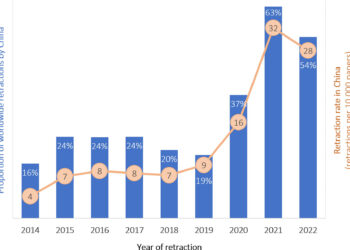
I first realized that academic publishing was going to be transformed by consumer media in January of 1994, when I stumbled on the Mosaic browser (progenitor to Netscape), then 3-4 months old, with its promise of making entirely new categories of information available directly to end-users. I was sitting at Encyclopaedia Britannica at the time, where we already had an Internet version of the encyclopedia in the works, but that version was being built for the library market. With Mosaic we pivoted and developed a consumer version, Britannica Online, which launched in October 1994. From that point on, or so it seemed to me, it was best to take one’s bearings from the likes of Yahoo! and GeoCities, later Amazon, AOL, ICQ, and countless others, until we come to the present age, which is dominated by the still-thriving Amazon, Google, Facebook, and Apple. The fact that some of these companies are no longer with us or are in conspicuous decline is beside the point, as we can learn from both the living and the dead. Do you want to develop a journal on the medical use of nanomaterials? How would Google do it?
I write as someone who is ambivalent about the content of consumer media, and on this score I imagine I have some spiritual bedfellows among the readers of the Scholarly Kitchen. But the form of consumer media — its shape, its flow — is another thing. Scholarly publishers did not realize that they would have to develop products and services for consumer media until they held an iPhone in their hands; librarians safely went about their business of cataloguing and acquiring various indexes to their catalogues, but then Google came along and changed the discovery of academic materials forever. No matter that Google makes much of its money from advertisements for products like hair pieces and sexual ointments, though I suppose there is some science behind those products, too.
Which brings us to House of Cards. Netflix has underwritten a new version of this multi-episode video (I don’t dare call it a TV show any more). The original version, starring Ian Richardson, was set in Britain; the new version has moved to corrupt Washington. Of course the “original” of the original is Richard III with a graft of Macbeth, but who’s counting? The new version (that is, the new new version) has adapted to the emerging habits of video viewers, who, instead of swallowing one episode per week, now routinely sit down on a Sunday and sit through 12 consecutive hours of their favorite show. This is something new, and it bears watching (in both senses).
For readers who don’t want to put 12 hours into this, I recommend the excellent piece in the New York Times, which describes the phenomenon well. Most important to me are the comments of people in the film/TV/video business about how the new viewing habits change the nature of the content itself. Shades of Marshall McLuhan! The medium really is the message. With people watching long works in a single sitting, there is less reason to shape each episode as a piece complete in itself. But perhaps most intriguing is that this emergent behavior takes all we have been hearing about shortened attention spans and throws it out the window. You could make quite a dent in “War and Peace” in 12 hours. Anyone up for the unabridged version of “Clarissa”? One producer remarked that people are now watching TV the way they read a novel. A novel? I thought the novel was dead, replaced by short, highly interactive multimedia with a game element.
Consumer media tell us that content evolves to fit its containers, that compelling content can break the time barrier (buck up, monograph publishers), that it is consumed in new venues (large-screen TVs, tablets, mobile phones), and that it is entirely unpredictable. It also tells us that the producers of content must look beyond the boundaries of the institutional market (the Mosaic example) to develop direct connections to end-users, a phenomenon I call library bypass. Consumer media are also developing their own form of altmetrics now that content is not exclusively measured by how many people tune in at 8:00 pm.
And so we in scholarly communications sit here with our wretched PDFs, which we download and print out before reading. A PDF is modelled on the printed page. For all the talk of digital libraries and digital this and that, we have barely begun to catch up with how we experience content in our non-professional lives.
Discussion
13 Thoughts on "What Consumer Media Can Teach Us About Professional Publishing"
Netflix is an interesting model to raise here. Their recent activity mirrors that of much of the tech world (and particularly that of third party distributors). There’s a growing sense that it’s increasingly risky to have your business rely on something you can’t control. Hence, Apple ditches Google Maps (perhaps prematurely) in order to escape any controlling influence Google might have on the iPhone/iPad’s continued development. Amazon’s book business, as another example, continues to rely on the goodwill and (seemingly shortsighted avarice) of the publishing industry. Rather than risk a point where publishers have Amazon over a barrel (as with agency pricing), Amazon is seeking to become a content producer, cutting out the publishers’ potential hold on their business. The same goes for Amazon’s budding video ventures, and like Netflix, rather than be forced to negotiate rights to content, they are instead investing in creating their own programs and movies.
How would this work for journal publishers? Could a publishing house become a research funder? Rather than waiting for others to pay for the research and hoping to pull in submissions, why not fund the actual research itself, requiring a first right of refusal for any papers that emerge? That would certainly free a publisher from any sort of worries about an Elsevier-style boycott, or having to change business models to suit a funder OA mandate.
Given the enormous expenditures required for most STM research funding, I’m not sure how feasible this would be (though perhaps eLife could be an early example of this). The math may not work–the amount of funding needed to generate results grossly outweighs the number of resulting papers and the maximum revenue they can generate. But for humanities/social sciences perhaps, where research funding is more scarce there might be some interesting possibilities. Invest in supporting the work of a few key scholars in a field in exchange for an exclusive right to their papers…
I cannot speak for my colleagues in humanities/social sciences, but my research group uses something in the range of $ 500,000 to $ 1,000,000 funding per year, and we publish on average 3-5 papers per year. I hope we publish nice papers, but if there is any publisher out there who is willing to foot such a research bill in return for an exclusive right to publish the ensuing papers, I will be very surprised…
Yeah, I figured the numbers wouldn’t work in most cases, and you’d want to concentrate on things like history or literary analysis, rather than buying someone a large hadron collider. But instead of funding an entire lab, what about funding discrete projects?
Still the same range of numbers, since an individual project in my field typically does not yield a publication every year. I actually did the math for a paper we published last year, and overall it cost ~$ 250 K to get that one project to publication (not including the fees paid to the publisher, which were ~0.5 % of the overall $ investment in the paper…)
Reblogged this on Informing with Data and commented:
Marshall McLuhan is evoked in this commentary on content as influenced by the medium.
I read Data Diet in Popsci last week about how consumerism has guided food production into a virtual object. Here’s a quote, “We have increasingly used data to trade virtual food as speculative objects.” The article indicates the disparity between the amount of food being produced and the amount being distributed to where the need is. There is more food and somehow more hunger than ever before.
I see the same trend with music. I’m afraid the music industry has researched the heck out of consumers and the result is everything now sounds the same, musicians can’t make a living and the quality of new music is poor.
I feel the same landslide in the publishing industry, namely book publishing. Have you tried to find a new book lately? All the same authors are writing all the same material and there are many of them giving up on the traditional publishing routs because they are not making money. So dig through the piles and piles of new indie books and eventually find a gem.
Just because data says a majority of people like something does not means it’s good. I’m afraid that data controlled trends will lead us to only having videos that feature cats playing the piano to watch and Oprah book club books to read.
Nathan,
Interesting perspective. I understand and agree. If content providers are all following what the data models say is in vogue,today, there will be nothing truly creative/innovative ever written or composed again.
Authors will only write what the mainstream wants and all writers will be indistinguishable from one another. I also agree that today’s music seems more like the Muzak of old than it does resemble anything remotely creative.
How sad, when data is used, or in this case misused, to determine the appetites of the consumer.
Cheers,
Marc
Try Scalar http://scalar.usc.edu/
The inertia of academe is likely to continue exerting a real drag on the inroads of consumerism into scholarly communication. E.g., as Columbia University Press discovered when publishing the innovative Gutenberg-e monographs, journals still wanted to receive something in print form to use for reviewing the monographs, even though no print version could fully capture the richness of the online product. Promotion and tenure committees still generally insist on submission of print materials for their review. We have a long way to go before the habits of iPhone users begin to infiltrate the halls of academe and change its ways of doing business.
When you’re reading all day long to make a living, the print page can be easier on the eyes. Hundreds of pages on an iPhone?
There is a solution to the wretched PDFs to which Mr. Esposito refers. It is not a pipe dream of the future, but rather a solution that exists today. If, instead of relying on the dead end technology of PDFs to communicate scholarly information, publication content was structured in an XML-first methodology, we could save trees (printing when we must), while increasing the distribution of same content to online delivery and the reflowable text of e-books. Multipurpose publishing without reinventing the wheel is what we should be gravitating toward. This approach works for for-profits, not-for-profits and for any organization that has content. Structure once . . . publish often. This will truly allow content to evolve to fit the still to be imagined container.



